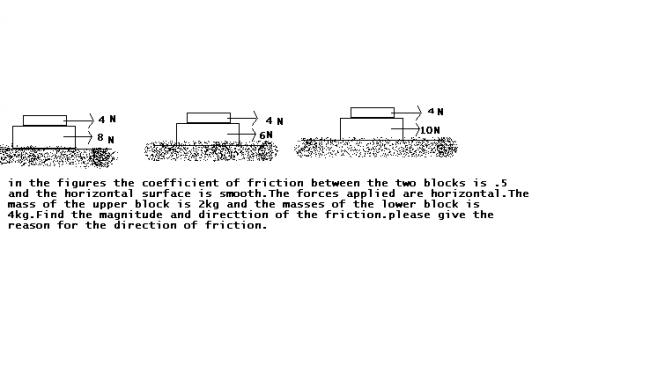sir wat will be the direction of static friction.so far i didnt know abt direction of static friction.wat will be the direction of static friction in the case for a body under pure roll.
23 Answers
yes sankara.. your observation is perfect.
I assumed that the blocks were initaillly at rest.
the direction of friction is always found by finding the relative tendency of motion of the surfaces..
yeah in a way..
slipping means kinetic friction will act... no slipping means static friction.
btw this is the reason why you will notice that hard balls travel much larger distance than say a rubber ball!
bcos hard balls will have lesser rolling friction!
In real life cases, rolling friction is very very important.
And that is why we never are able to achieve what is pure rolling.. like if we could put v=ωr for a real ball.. but it would still stop after some distance.. this is due to rolling friction (deformation of ball!)
For a pure rolling body, all problems that you will encounter in JEE will have static friction.
rolling friction is a completely different creature...
See the rolling friction is the one which is formed by deformation fo the bodies or body in contact. We only need to know the theory of that one. I have never seen a numerical in my life on this one....
i got clear in this type of friction sir.
another question.
wat is the type of friction that acts on a pure rolling body.
is it static or rolling please give me reason.
so by ur example or observation, in the first case itself, we can say that the direction of the friction will be such that it will opposse the relative velocity..
but after a small motion the blocks will have same velocities.. bcos of the difference in their accelerations.. and then the blocks will move together!!!!! so the friction will cease to act!
1st f=8N forward direction
2nd f=3.33N forward direction
3rd f=4.67N forward direction
( r the ans correct )
sir in this example we r concluding that if there is no rel acc then there is no friction force acts.in this example there can be relative velocity between the blocks we r not considering abt the relative velocity
vishal try to solve the first case and find the acceleration of the blocks.. then may be we can do some more discussions as to whether u understood what i am trying to say!
vishal... friction has the tendency to oppose relative motion...
Sorry if i am not making sense... could you give me somethign concrete... as to what you have not understodd...
Actually I did not understnad the point where u are differing!
yes it can act when there is no relative motion too sankara...
see for example .. when you slightly push a block but the block does not move..... There is no relative motion.. but friction is acting. *(This is a very very simple example!)
Great vishal... try to check your reasoning dear... Did I ever say that!
sir one question
friction force can act only when there is relative motion
can it act when there is relative velocity between the surface
@ nishant why will friction try to prevent relative motion
r u trying to say that upper block will always move with the lower block
on the lower block i have assumed no friction between the block and the ground.
1st find the net acc of system ie anet=net force/net mass
then find force for upper mass if the upper force is less than μmg then firction is equal to that force (ie anet * mass of upper body)
if force acting is less than friction then friction is making the upper body to move with lower body so friction is in forward direction
hope u understood
:)
sankara
To find the direction of friction. you should first find the relative motion between the surrfaces (Without considering the friction!!)
IN the first case... the relative motion is zero.. because there is equal acceleration of both the blocks..
a=8/4=4/2
So friction will not be acting
In the second the upper block has higher acceleration. The friction will try to prevent relative motion and hence act in the backward direction on the block at the top and in the forward direction on the block at the bottom.
If you have understood this logic.. you should be able to solve the last case. Pls do so .. so that we can be sure that u have understood :)
Great vishal i dont have the answer. can u please give me the reason for the direction of friction.
